18 Centuries of Empire: The Greek Perspective
[after the Persian Emperors] Alexander
the Macedonian [ruled for] 8 years; ... Cleopatra 22 years; Augustus 43
years; ...
--- The Canon of
Kings by Claudius
Ptolemy of Alexandria, ca. 165 AD.
Proclaim yourself ‘Emperor of the
Hellenes’
--- advice to Emperor Constantine XI by
John Argyropoulos of Constantinople, 1449 AD.
Last
updated: 27 August 2011.
In the rest of this web site I dated the beginning of the Roman
Empire as 338 BC, when Rome asserted its rule over the other Latin
cities. The same year saw Phillip of Macedon establish hegemony over
most of Greece, creating the first pan-Hellenic Empire. Phillip's son
Alexander would turn this into the greatest empire the world had yet
seen. This fragmented after his death, but at least one successor
kingdom (the Ptolemaic) lasted until the death of Cleopatra in 30 BC,
when it was annexed by
Octavian, better known as Augustus, the first Emperor of Rome.
As the first quote below the title
shows, two centuries later, some Greek intellectuals
already viewed the Roman Empire as the direct successor to the
Hellenistic kingdoms. The Canon of
Kings, compiled as a dating system
for the period 747 BC to 160 AD, was based on a Mesopotamian list that
began with the Babylonian kings and continued through to the last
Persian emperor, Darius III. It was the Greeks who subsequently
appended the list of Macedonian emperors, Ptolemaic sovereigns, and
then Roman emperors. These "Roman" emperors of course continued until
1453, but
became increasingly Hellenized over the centuries; the second quote above shows the conclusion
eventually reached by some Greek
intellectuals.
This page presents "the Empire" from this Greek perspective of translatio imperii. It
began with
Alexander's accession in 336 BC, and continued (fragmented) until it
was succeeded by the Roman empire in 30 BC. Although the Romans
conquered the Greek kingdoms
and cities, they had little impact upon their language or culture. The
Greek
identity of the eastern half of the Empire began to be reasserted under
Diocletian (the first emperor from a Greek family) in 285 AD. In the
long
run, it was this Greek part of the Roman empire that survived intact,
to become the Mediaeval "Byzantine" Empire. The birth of the Byzantine
Empire is
variously dated anywhere from 285 AD to 629 AD (the latter date being
when, under Heraclius,
Greek replaced Latin as the Imperial language). The last successor
states to the Byzantine Empire fell to the Turks in 1460/61 AD,
and an independent Greece re-emerged only in 1827.
This history is presented in the form of 9 maps, covering the 18
centuries from 336 BC to 1458 AD, plus another map showing the
present-day Greek nations. These maps cover a different (much wider)
stretch of the world than those in the 18
centuries of
Roman Empire page. They also differ from those maps in that
the time between maps is not roughly constant, but instead increases
monotonically. This reflects the astonishingly rapid pace of Alexander's
conquests, and the almost equally rapid dissolution of his empire. It
also reflects a desire not to replicate too much of the information
shown
elsewhere on this site: one map reproduces the Byzantine empire at 1040
shown in the 18
centuries of
Roman Empire page, another the empire at 633 shown in The
Dragon and
the Eagle; all of the rest are new.
Note: to view these maps as a
coarse "movie", first adjust the size of
this window to be slightly larger than a map plus its title, then click
on next (>) or previous (<) at the beginning of each title. To
return
to the Index of Maps, click on the up arrow (^).
Index of Maps
336 BC -- Alexander's accession
323 -- Alexander's empire at his death
300 -- The Diadochoi
200 -- Just prior to Roman intervention
34 BC -- Cleopatra and Antony: the final stand
285 AD -- Diocletian's Division of the Empire
633 -- Heracleios the Basileus
1040 -- The Byzantine Empire at its height
1458 -- The Last Byzantine Kingdoms
Now -- The Present Greek States
Summary Map of Greek Civilization
Summary Map of Greco-Roman Civilization
^ > 336 BC --
Alexander's accession
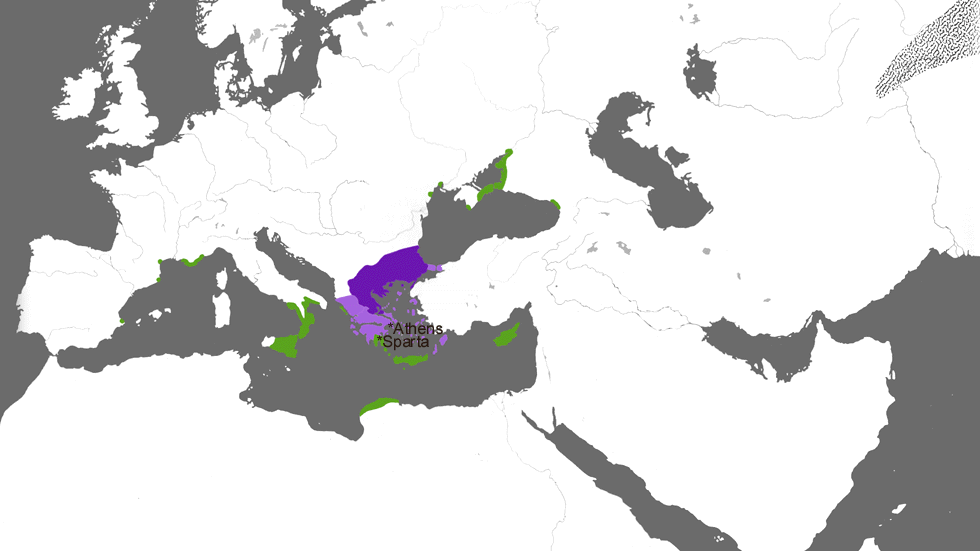
The Glory that was Greece --- the age that produced the philosophy,
art, and literature that would define Western culture --- owes its
existence to the victory of the Greek city states, led by Athens and
Sparta, against the invading forces of the vast Persian empire in
480-79 BC. But despite this crushing victory, there was no great Greek
counter-offensive, and the Persians even regained Iona (the west coast
of Anatolia) in 386. Instead, the Greeks of the Classical Age
occupied themselves militarily by enlisting as mercenaries in the
Persian armies or by fighting inter-city wars (principally involving
Athens, Sparta, and Thebes). These (in hindsight) petty struggles were
brought to an end by Phillip of Macedon, a Hellenized kingdom to the
north of Greece proper. The strengths of his army were two-fold: (i)
the Macedonian phalanx, many ranks deep, each armed with a pike 5m or
more long; (ii) the Thessalian cavalry. In 338 these forces defeated
the combined hoplite armies of Athens and Thebes, the crucial action
being the cavalry charge led by Phillip's teenage son Alexander that
turned the flank of the Thebans. This victory brought all of Greece bar
Sparta under Phillip's rule. In the above map, the Macedonian kingdom
itself is shown in royal violet, and the states owing allegiance to
Phillip in a lighter shade; independent Greek states (the colonies from
Spain to Colchis, plus Sparta), are shown in green. Not content with
these
conquests, Phillip announced his plan to lead the Greeks against
Persia, to finally avenge the Persian invasions. On the eve
of his departure in 336 he was assassinated, and the 20-year-old
Alexander rose to the Macedonian throne.
< ^
> 323 --
Alexander's Empire at his death.
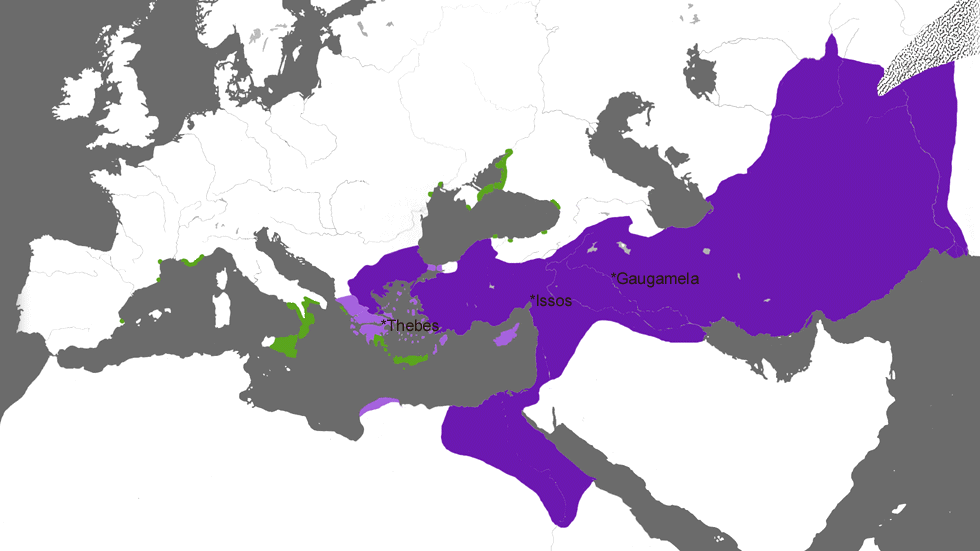
If the Greek cities thought that Alexander was not be the man his
father had been, they were right: he was even more ruthless and
ambitious. When Thebes rebelled against Macedonian rule in 335,
Alexander razed the city. The next year he crossed to Asia, defeated
the Persian forces, and occupied Anatolia. In 333 he won an
overwhelming
victory against the Persian king Darius III himself at Issos, and went
on to conquer the levant and Egypt. Darius offered him peace based on
the status quo, an offer
which Phillip surely would have accepted. But Alexander, having been
hailed as semi-divine in Egypt,
disdained it. In 331 at Gaugemela he won a second overwhelming victory
when Darius fled the battle. In all of these engagements the Greeks and
Macedonians were heavily outnumbered, and the cavalry charges led
by Alexander were decisive. Alexander followed Darius east, but the
latter
was eventually assassinated by a rival, whom Alexander promptly
defeated
also. Alexander led his army to the ends of the Persian Empire, and
even beyond it into India, founding cities all the way. Only a
threatened mutiny by his homesick troops in 326 prevented him from
advancing down the Ganges. He returned to Babylon, heartland of the
Persian empire, where he legislated to bring together his Persian and
Greek
subjects. But his administrative skills had little chance to be
exercised, as he died there in 323, aged only 32. He had spend half of
his short life in hard fighting and hard drinking; this, plus a
near-fatal wounding in India, had finally taken their toll on
Alexander.
< ^
> 300 --
The Diadochoi.
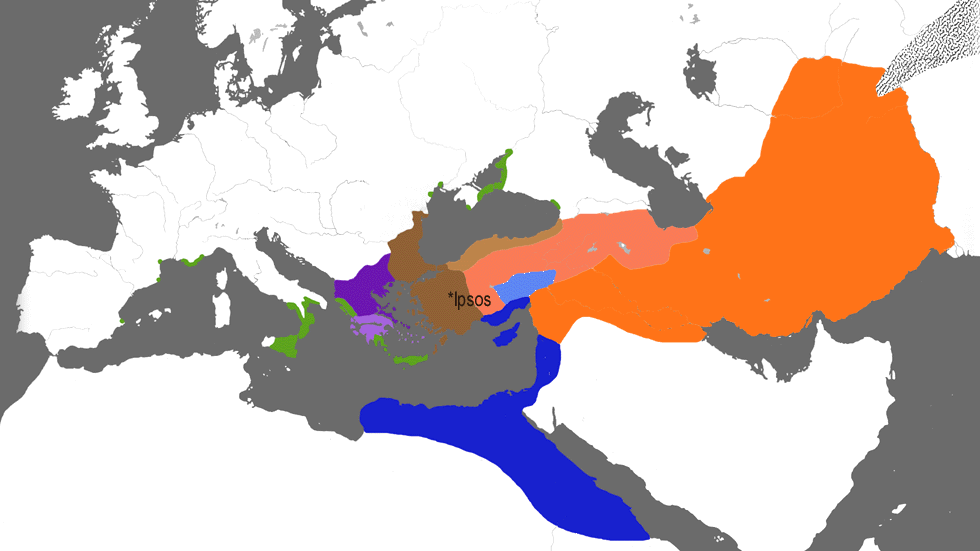
On Alexander's death his empire fell to his retarded half-brother
Phillip and his
only legitimate son, also called Alexander, who was still in utero. Unsurprisingly, his
generals began to consolidate their
holds on various parts of the Empire, rather than maintaining loyalty
to these incapable heirs. These generals became known as the diadochoi, the successors, and they
soon fell to fighting amongst themselves. Phillip was
assassinated in 317, and the young Alexander in 306, just as he came of
age. Thereafter the diadochoi
began styling themselves as kings (basileioi).
One
successor, Antigonus, still dreamed of reuniting the Empire, but the
other diadochoi joined forces
to defeat him in the battle of Ipsos in
301. After this a slightly stabler political situation emerged, with
four
successor kingdoms, indicated by the different colours in the above
map, with their areas of influence indicated by paler shades. The
kingdom of Macedon (coloured royal violet as before) was ruled by
Cassander, who had married the daughter of Phillip. Thrace and western
Anatolia formed the kingdom of Lysimachus (brown). Ptolemy (blue) held
the kingdom of Egypt, (blue), and extended his rule to Palestine and
Cilicia as well. The fourth and largest successor kingdom was that of
Seleucus (orange) who ruled from Syria to the Indus. Alexander's
conquests beyond the Indus had been abandoned by Seleucus to the Maurya
Empire in India, in exchange for 500 war elephants, which proved their
worth in the battle of Ipsos. Apart from this loss, and the loss of
Alexandria Eschate (Alexandria the furthermost) in Central Asia, the
combined kingdoms of the diodochoi extended beyond that of Alexander's
empire (although only if dependent areas are included).
< ^
> 200 -- Just prior
to Roman intervention.
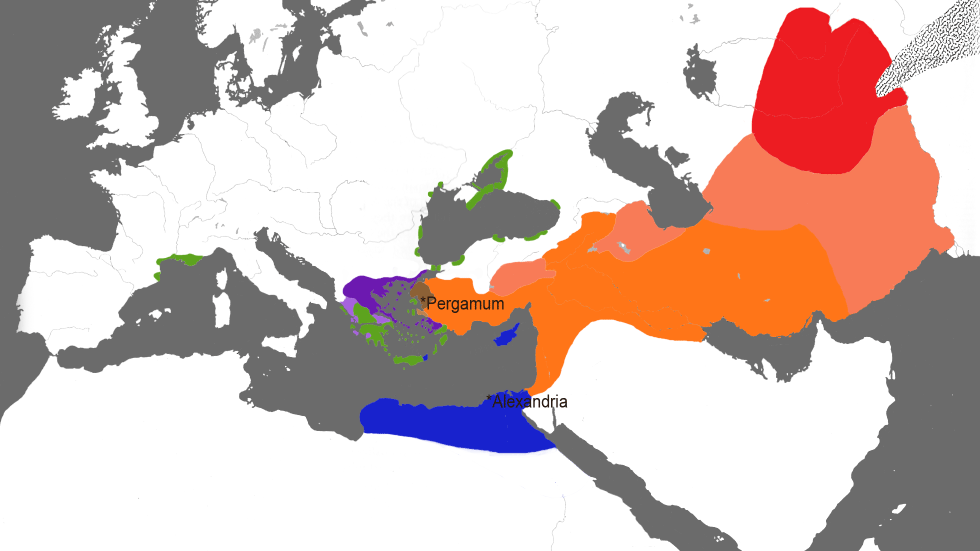
Wars between the successor kingdoms continued for another twenty years.
Lysimachus finally added Macedon to his kingdom in 285, but this led to
war
with Seleucus, who conquered Lysimachus' Asian territories. During this
war, both of them were murdered in 280 (of the original diadochoi, only
Ptolemy had died peacefully, in 282). In the ensuing confusion, the
Celts invaded the Balkans and Anatolia in 279. The remnant of
Lysimachus' original kingdom was overwhelmed, and the Greek cities
regained their independence from Macedon. The Macedonians then accepted
as their
king
Antigonus II, grandson of Antigonus the diodochos. In central Anatolia,
the Celts (or Gauls) settled in the region thereafter known as Galatia,
screening the Black Sea coast from the influence of the Seleucid kingdom
(so named after its founder). This kingdom now began a slow and erratic
decline towards its demise two centuries later. The north-eastern parts
broke away to form the kingdom of Bactria under Diodotus around 245
(this new successor kingdom is shown in red). The Parthians, to the
west of Bactria,
also became semi-independent around the same time, while in western
Anatolia,
Attalus of Pergamum declared himself king in 230 (the territory shown
in brown). But
at the time of this map (200 BC), Antiochus III was leading a revival
in
the Seleucid kingdom, campaigning as far as India (to collect more
elephants as tribute) and capturing the
eastern Mediterranean coasts from the Ptolemaic kingdom of Egypt. He
was joined in the latter endeavour by Phillip V of Macedon, who also
reasserted the Antigonids' influence in parts of Greece.
This alliance caught the attention of ascendant Rome, which had
recently defeated Carthage and conquered Graecia Magna (southern Italy and
Sicily). By contrast, the Greeks of Egypt were no longer a military
force to be reckoned with (they had temporarily lost control of Upper
Egypt at this time). But in cultural terms they were unrivalled.
Alexandria in Egypt was the centre of the Greek intellectual and
artistic world, and, with a population of perhaps 400 000, the largest
city the world had ever seen.
< ^
> 34 BC -- Cleopatra
and
Antony: the final stand.
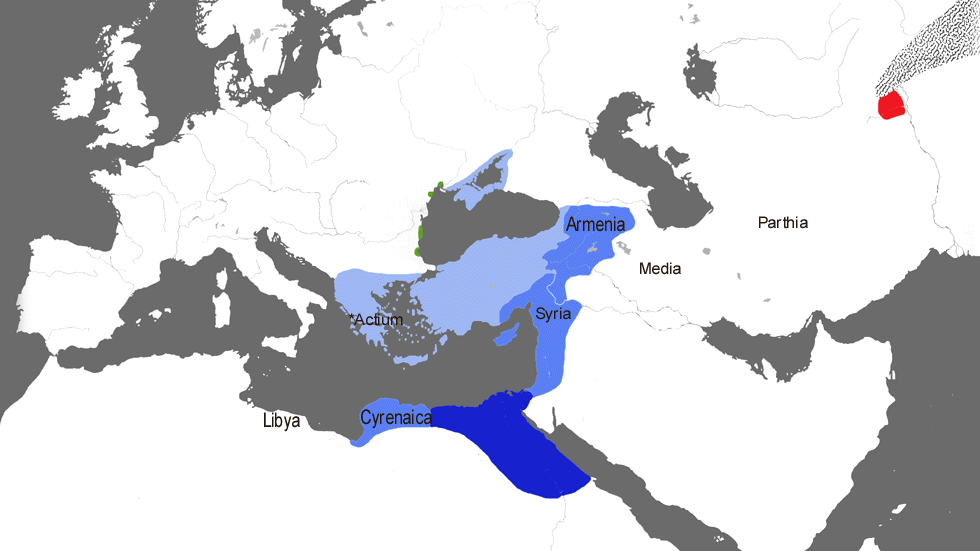
In 198, two Roman legions landed in Greece and broke forever the power
of the Macedonian phalanx. At the Olympic games of 196, the Greek
cities were told they were free of their Macedonian overlords, but the
reality was that the Romans were the new overlords. In 192, Rome went
to war with Antiochus III, trouncing him as well. In the peace treaty
of 188, the Seleucids lost most of their Anatolian territory, the chief
beneficiary being
Pergamum, a Roman ally. After this, the Seleucid position east of
Mesopotamia began to fall apart, as the power of the Parthians grew.
Following further wars, Rome annexed Macedon and Greece outright in 148
and 146 respectively. Bowing to the inevitable, the last of the Attalid
kings bequeathed Pergamum to Rome on his death in 133. By this time,
the Seleucids had been confined to Syria and Palestine, and their
territories had shrunk to a few towns there by the time Pompey annexed
the area
for Rome in 64. Of Alexander's successors this left only the Ptolemys
in Egypt, who had long been under Roman protection (*). The last of the
Ptolemys, Cleopatra VII, maintained her kingdom's independence through
her close relations with two leading Roman men. The first was Julius
Caesar, who put her on the throne in 48. To him she bore a son,
Caesarion, whom she named as co-ruler. The second was Mark Antony,
ruler of the eastern part of the Roman empire following Caesar's death
in 44 (the western
part was ruled by Octavian). She had three
children by Antony, and married him in 37. In the "Donations of Alexandria" in 34, Antony
created kingdoms for his Greek family out of the territory Rome had
acquired over the previous 40 years in the east: for Cleopatra and
Caesarion, Cyprus was restored to the kingdom of Egypt; for his son
Alexander Helios, Armenia (and, nominally, Media and Parthia, which
Antony planned to conquer); for his daughter Cleopatra Selene,
Cyrenaica (and, nominally, Libya, which was controlled by Octavian);
and for his younger son Ptolemy Philadelphus, Phoenicia, Syria, and
Cilicia. These territories are shown in pale blue, in the above map,
while Antony's Roman territories are shown in even paler blue.
(*) Another successor kingdom is also shown in red in the above map:
the remnant of
the Bactrian kingdom around the Khyber pass. The later history of this
kingdom is obscure and it may have already disappeared by 34 BC, the
time of
this map.
< ^
> 285 -- Diocletian's
Division of the Empire
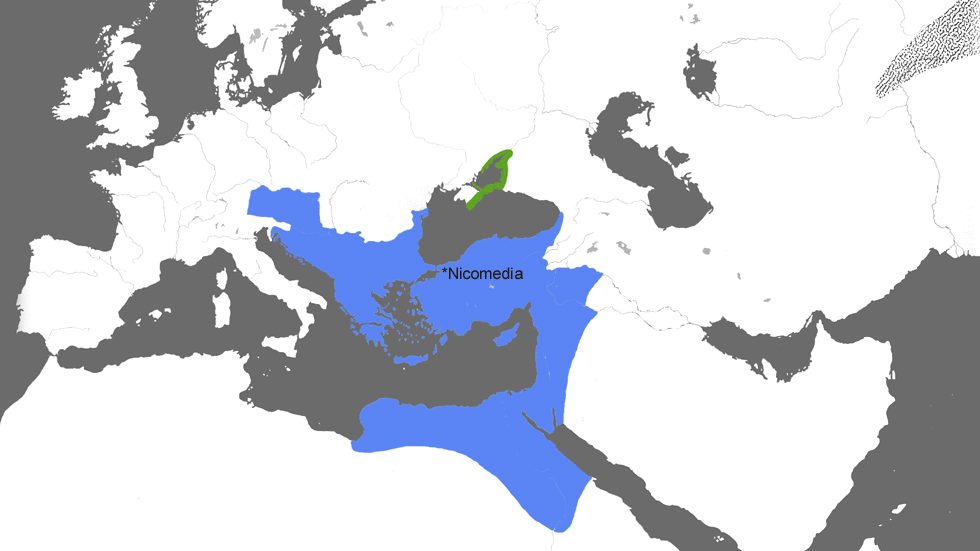
With the riches of Egypt and the might of his veteran legions behind
him, Antony's
ambition of conquering Media and Parthia was no mere pipe-dream. If
he had succeeded then he and Cleopatra would have reunited almost the
whole Empire of
Alexander the Great. But the fates had other plans. In 32 BC,
Octavian convinced the Senate in Rome to deprive Antony of his office
and to declare war against Cleopatra. A third of the Senate, and both of the Consuls, fled to
Antony in Greece, where he and Cleopatra had gathered their forces. But
Antony's consorting with Cleopatra had alienated his legionaries, and
they defected to Octavian in droves. Facing defeat in the battle of
Actium (see preceding map) of 31 BC, Cleopatra
fled back to Egypt with
her navy, followed by Antony. Octavian invaded Egypt the following
year, and the lovers committed suicide. Octavian annexed Egypt and
returned to Rome where, in 27 BC, he was granted the title Augustus,
becoming the first Roman Emperor. Virtually all Greek states were now
Roman provinces, or Roman dependencies. Over the next few centuries,
Greek culture and customs, such as inhumation (rather than cremation),
spread over the whole Empire. In the east, Greek remained the lingua
franca except for dealings with Imperial governors, law courts, or
the army. In 284, Diocletian became Emperor, the first to come
from a Greek family (his Imperial name is a Latinization of Diocles). The following year he
revived the idea of having two rulers for the Empire, as it had been
under Octavian and Antony. He installed Maximian in the west, ruling
from
Milan, while he ruled the east, from Nicomedia. Diocletian's
demi-Empire, the first major state for over three centuries having
Greek as its lingua franca, with a
ruler of Greek origin and his court in a Greek city, is shown above in
pale blue.
< ^
> 633
-- Heracleios the Basileus
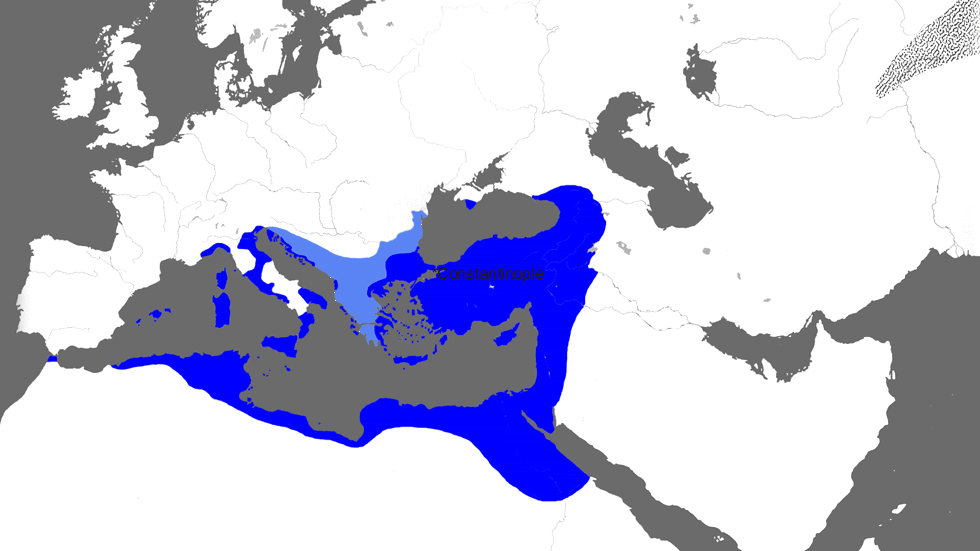
Diocletian's system of governance did not long survive his voluntary
retirement in 305, and by 324 the Empire had a single Emperor again:
Constantine. He is justly called the Great for two momentous decisions.
First, he recognized that the eastern part of the Empire needed a
proper capital, and founded New Rome (soon known as Constantinople) on
the
site of old Byzantium. Second, he embraced Christianity. By 395 these
decisions had completely changed the nature of the Empire. Christianity
had become the state religion, and the Empire was permanently divided
into eastern and western halves, each with an Emperor, court, and
Senate. Over the next century the western Empire fell to Germanic
invaders, while the eastern survived intact. From 533 to 563 much of the
west was reconquered from the east, but now there was only one Emperor,
court, and Senate, all in Constantinople (see here).
Half of these
gains were lost
again by 629, leaving the Empire predominantly Greek once more, despite
the loss of direct control over much of the Balkans due to Slavic
settlement. The Emperor Hercalius, recognized this reality by adopting
Greek as the official language of the Empire, becoming the Basileus Heracleios (*). Nominally
still Emperor of the Romans,
Heraclius was in fact the first Greek Basileus since Cleopatra, and the
colouring in the above map reflects that. At the time of this map,
Heraclius had recently reconquered
the easternmost provinces (corresponding pretty much with the kingdoms of
Cleopatra and her children in 34BC) from the Persian Empire which
had
invaded in 602.
(*) This term, when used by Alexander the Great and his successors, was
translated
above as king. Since the time of Constantine the Great, however, it had
been used exclusively for the Roman Emperor and his Persian
equivalent.
< ^
> 1040 --- The Byzantine
Empire at its height
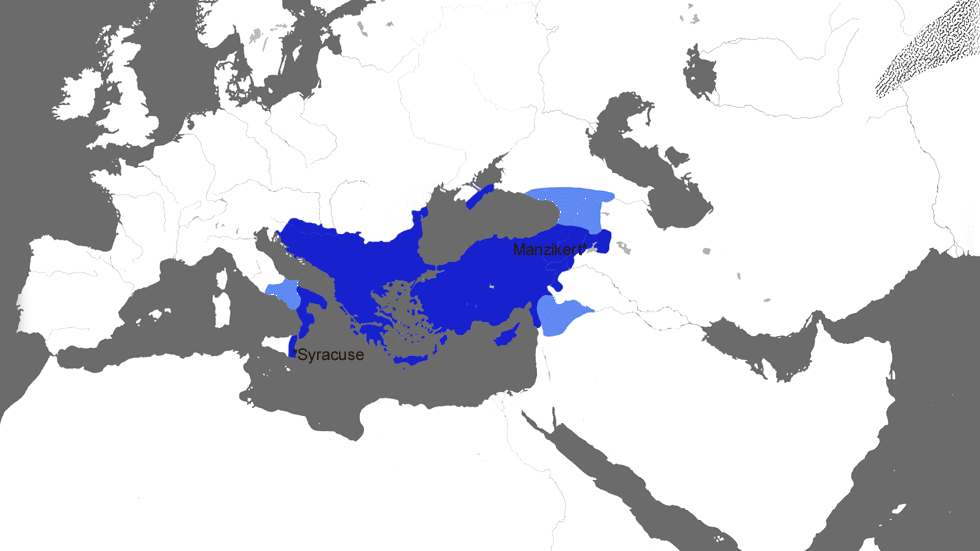
Unfortunately for Heraclius and the Greeks, all the territory they had
just regained from the Persians was lost to the Arabs from 634 to 651.
His successor Constans II (641-68), having been defeated by these
forces of Islam, turned westward to restore the Empire's fortunes in
660. He was the first Emperor to visit Rome in two centuries, and held
court in the old Greek city of Syracuse, within easy reach of southern
Italy and Latin-speaking Africa. His plans to make Syracuse the new
capital led to
his being assassinated there in 668, and within thirty years all of
Africa had fallen to the Arabs. Once again, this time finally, the
Empire was reduced to an area that was predominantly Greek-speaking.
The Empire's fortunes reached a nadir around 754 (see here), from
which it slowly recovered. By 1040 all of Anatolia, the Balkans, and
southern Italy were part of the Byzantine Empire, as were parts of
Armenia, Syria,
and (since 1038) Syracuse again.
< ^
> 1458 --- The Last Medieval
Greek States
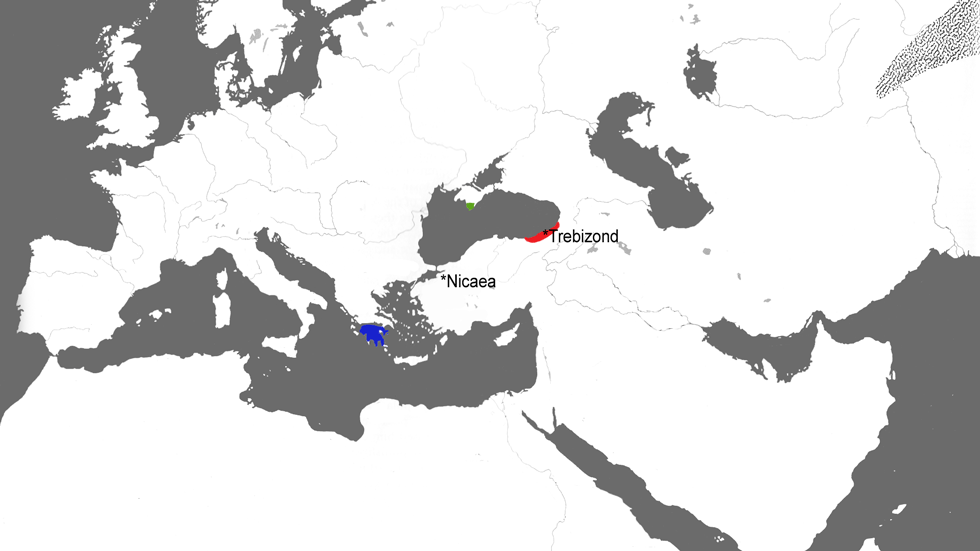
In 1040 the Byzantine Empire still had more than four centuries years
to run --- a century longer than the whole existence of the Empires of
Alexander and the Diadochoi.
But for most of this time the Empire was a
shadow of its former self, because of two massive blows. The first, in
1071, was its defeat by the Seljuk Turks in the battle of Manzikert
(shown on the preceding map),
after which all
Anatolia was overrun by the Turks. The western and coastal areas were
recovered with the help of Crusaders from western Europe in the 12th
century, but these Catholic armies were always suspicious of their
Orthodox brethren. The second blow was in 1204, when the Crusaders,
having helped put one Emperor upon his throne, rose up against him and
sacked
Constantinople. These Crusaders grabbed the central parts of the
Empire,
around the Aegean, while three major Byzantine successor states emerged
on the periphery: the Empire of Nicaea in western Anatolia, the Empire
of Trebizond in northern Anatolia, and the Despotate of Epirus on the
Adriatic (see here). The
struggle to re-establish the Empire
was won by Nicaea, which regained
Constantinople in 1261, and finally
absorbed Epirus in 1340. Trebizond
remained independent but its
Emperors generally recognized the superior status of the "Emperor of
the Romans" in Constantinople. The last Emperor in Constantinople,
Constantine XI
(1449-1453) died in the fall of his city to the Ottoman Turks.
The Ottomans mopped up the few remaining Aegean Islands the Empire had
held, leaving by 1458 only the Despotate of Morea, ruled by
Constantine's brothers Thomas and Demetrius. At this time, Morea was a
hotbed of intellectual activity, promoting Plato's philosophy and even
a return to worship of the ancient Greek pantheon! Trebizond (red) still continued under the
"Emperor" David, and there was also the independent Principality of Theodoro in the Crimea
(green), with a mixed ethnic composition (it was also known as Gothia!)
but ruled by Greek Princes.
< ^
Now --- The Present Greek States
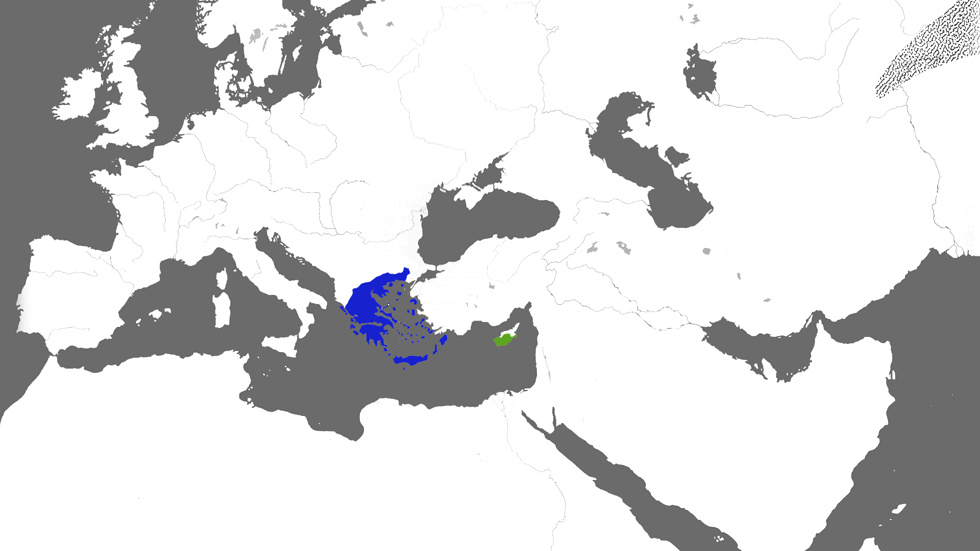
Morea was conquered by the Ottomans in 1458-60, Trebizond in 1461, and Theodoro in 1475.
From then there were no Greek states for 350 years, until the republic of Hellas won its war of independence
from the Ottoman Empire (1821-27). The Great Powers imposed a Bavarian
as king in 1832, and he styled himself, as
Constantine XI had been
urged to do, Basileus of
the Hellenes. This kingdom
comprised Morea
and central Greece, leaving the great majority of Greek speakers
outside its borders. At this time many Greek nationalists believed in
the Megale Idea (Great Idea),
of reuniting all Greek speakers. There were still Greek
majorities in parts of Anatolia, especially around Trebizond, and a
substantial minority in Constantinople, so the Megale Idea effectively
meant restoring the Byzantine Empire. In the wars of the late 19th and
early 20th centuries, Greece came close to this goal (see
here), but
defeat by the new Turkish republic in the war of 1920-23
meant that Greeks had to be content with the area shown above in blue
(which also includes Rhodes, ceded by Italy in 1945).
Athens, the Classical centre, rather than Constantinople, the Mediaeval
centre, would be the capital of
modern Greece. However, events in Cyprus showed that
the
Megale Idea still had a hold
over some Greeks in the 1970s. This
island, which was 80% Greek-speaking, had been lost to Crusaders in
1190, conquered by the Ottomans in 1571, annexed by Britain in
1914, and given independence in 1960. Political pressure by the
military rulers of Greece (1967-74) on Cyprus to unite with Greece,
against the wishes of its substantial Turkish minority, led to the
Turkish invasion of the island in 1974. This established a de facto Turkish state in the
northern third of Cyprus, leaving only the southern two-thirds under
the internationally recognized Cypriot government. This latter state,
almost entirely Greek in population, is shown in green above. Note
finally that modern Greece would closely approximate Phillip's
Macedonian Empire, if Thrace were added, and Sparta and Crete
subtracted.
Summary Map of Greek Civilization
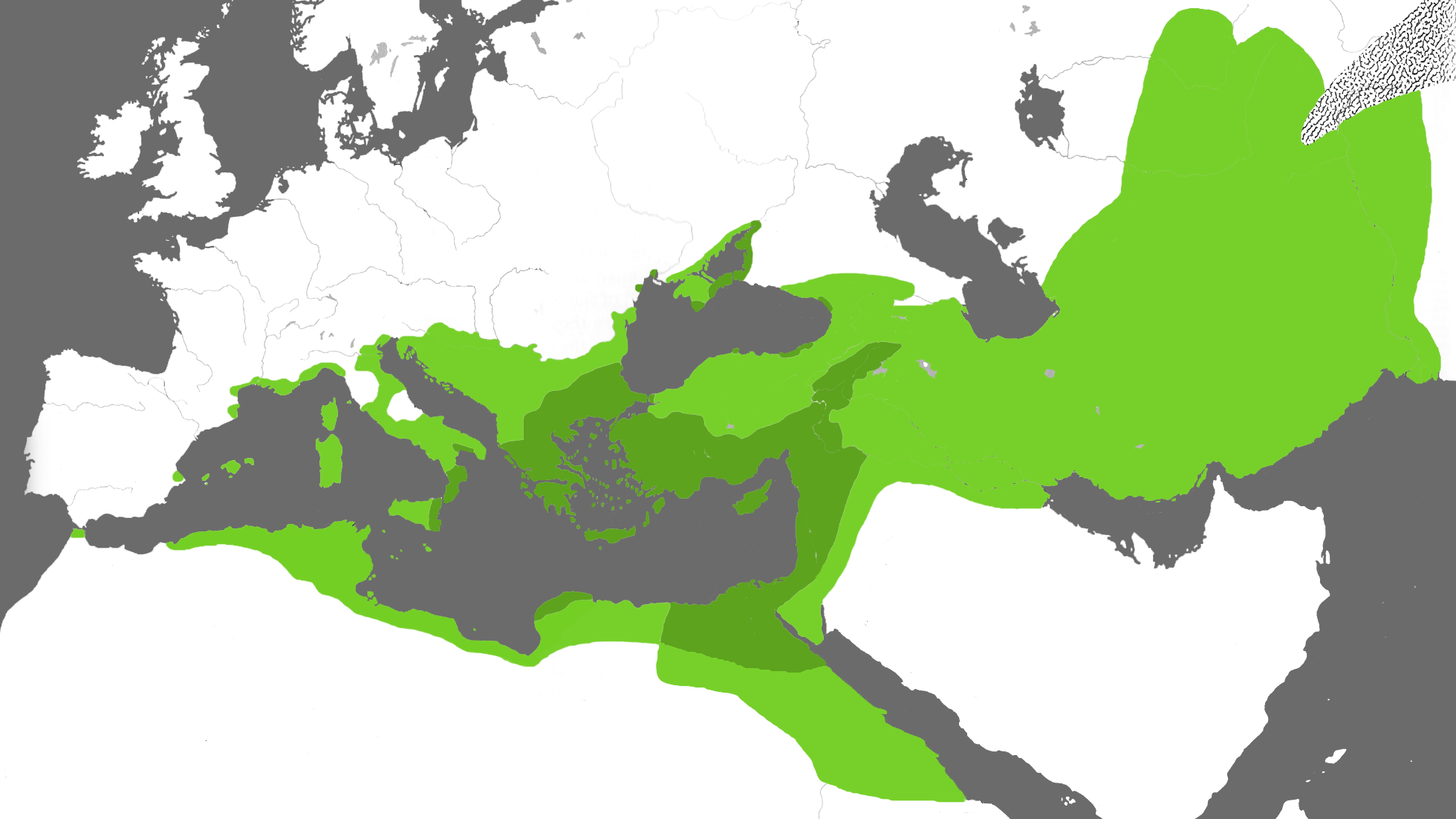
This map shows is a summary of Greek civilization as portrayed in the
ten preceding maps, from 336 BC to the present day, not including the
areas shown in a very pale shade in the map for 34 BC
(Roman areas controlled by Antony), nor the area shown in the map for 285 AD (controlled by Diocletian). Shown in
dark green are those areas appearing in at least half (i.e. five) of
the above maps, with pale colouring in the above maps counting for
half. Shown in paler
green are those areas appearing in any of the above maps. The dark
green areas, the "core" greek areas, consists of a continuous
band of territory including Greece
proper, Macedonia, Thrace, western Anatolia, Cilicia, Syria (including
Phoenicia and Palestine), Lower Egypt, and a sliver of Armenia that just
makes
it in the count. It also includes the islands of the Aegean and Cyprus,
plus Cyrenaica, Magna Graecia,
and some of the Black sea coast. The paler green areas stretch from
India to Morocco, considerable larger than Alexander's
Empire, principally because of the European and African territories
of the Byzantine Empire.
Summary Map of Ancient
Greco-Roman
Civilization
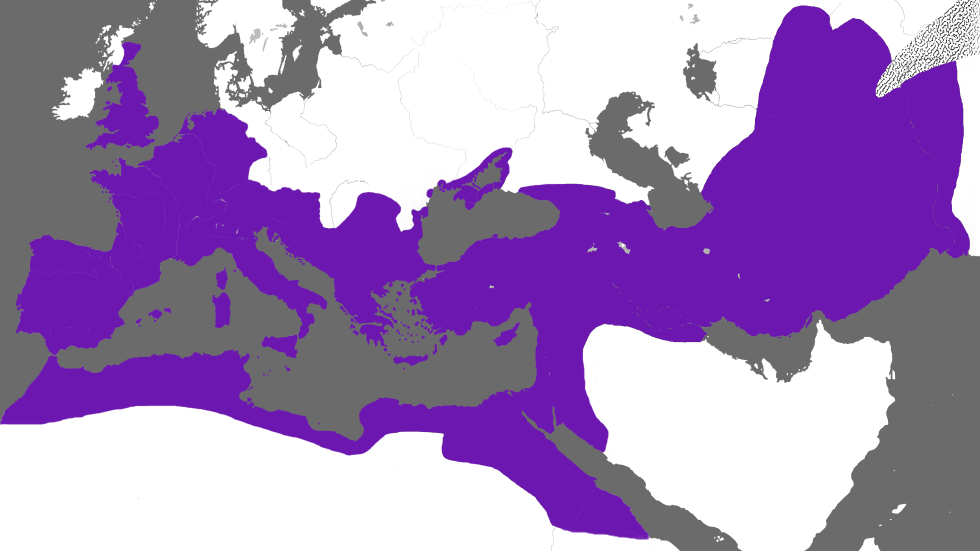
This map shows all of the areas that were under Greek or Roman
government at any time in Antiquity. Given the influence of Greek
culture in the Roman Empire (west as well as east), it can also be
interpreted as showing the spread of Greek culture in Antiquity. In
fact it is not necessary to
consider the whole of Antiquity; this map would be unchanged if the
time period were restricted to the Hellenestic period and the Principate. Indeed, it would not be greatly
changed if it comprised simply the union of Alexander's
Empire in 323
BC and Trajan's Empire in 116 AD. It is remarkable then,
that
the above area requires, in the present day, approximately forty-five
nation-states (*) to govern it.
(*) This tally includes Luxemburg but no microstates,
and includes only states with at least one third of their population
lying within the above boundaries.
Return to the Roman Empire main
page











